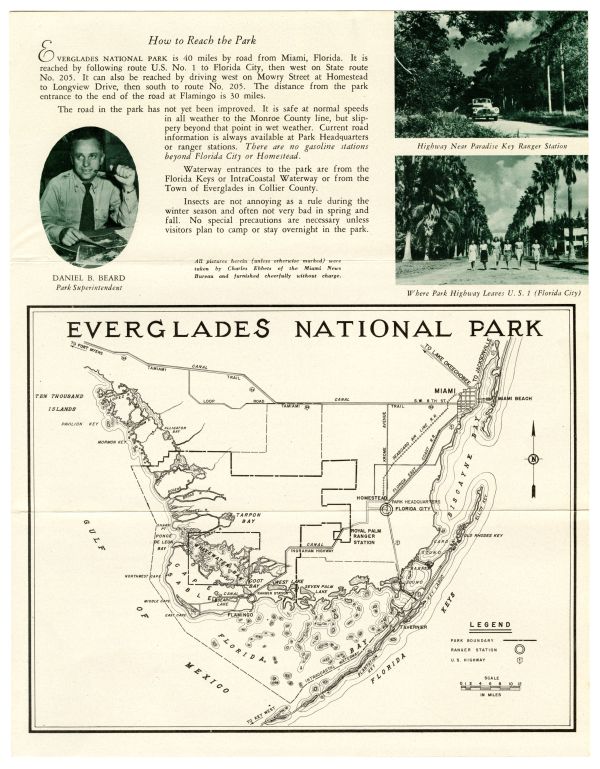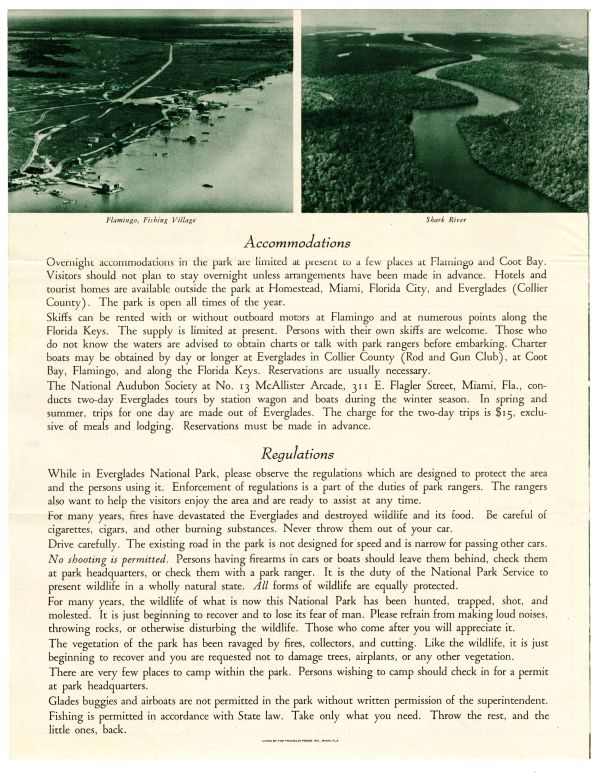Transcript
Everglades National Park Florida
[Photo]
An Ibis Rookery
[Photo]
Solitude at Sundown
Everglades National Park is the 28th national park in the United States and Territories. It is administered by the National Park Service of the United States Department of the Interior. The Park Headquarters is at Homestead, Florida on highway U.S. No. 1. The mailing address is P.O. Box 275, and the telephone Homestead 441.
The Everglades National Park Commission is an official State agency with offices at 604 Biscayne Building, Miami 32, Florida, in charge of Gilbert D. Leach, managing director.
This Leaflet was written by Daniel B. Beard, Superintendent of Everglades National park, and published by the Everglades National Park Commission in May, 1948.
[Photo]
Cape Sable Beach, Famous for Shells
[Photo]
Ibis Rookery on a Key
[Photo]
Closeup of White Ibis
[Photo]
Flowering Air Plants
[Photo]
Part of Crowd at Park Dedication
[Photo]
Good Fishing
[Photo]
Bill Stapleton, Miami Herald
Great Snowy Egret Eyes an Alligator
Everglades National Park now consists of approximately 500,000 acres of land and water in the extreme south and southwestern tip of the Florida peninsula. An acquisition program is under way which will increase its area to approximately 1,300,000 acres. The Park was established on June 20, 1947, and does not yet have the facilities for full public use which are normally associated with national parks. It is a subtropical wilderness area with but one access road. The park was a gift to the nation from the people of the State of Florida. It is essentially a biological park which will feature unique vegetation and wildlife that is noteworthy because of its abundance or its unusual forms.
Physiography
Geologically, the park is new land and still forming. It is an excellent example of the primitive, earth building forces of nature. The Miami Rock Ridge of oolithic limestone extends into the park and is covered with dense hammock vegetation or pines. (The word "hammock" is commonly used in southern Florida for tree islands in the Everglades prairies. It is said to be derived from the Indian word meaning "garden place" as hammocks were used extensively by the Indians for gardens.) The open Everglades prairies are composed of muck and marl with numerous sloughs, estuaries, and lakes, dotted with hammocks in the grassy prairies. The Mangrove Coast of the park along its western and south-western sides is dissected by numerous islands, bays, and rivers. There are approximately 14 miles of primitive beaches at Cape Sable. Prevailing vegetation is of red, black and white mangrove. These species of trees sometimes rise to unequaled height along this coast.
Vegetation
The plant life of the park is quite unlike that of any other region in the United States. About 90 species of trees and 100 shrubs, most of them of West Indian types, occur in the park. This includes 8 types of native palms, cypress, broad-leafed hammock vegetation, and numerous air plants among which are about 30 species of orchids.
Wildlife
No other national park contains so many rare forms of animal life. Among the mammals are the Florida black bear, Florida cougar or panther, bobcat, white-tailed deer, otter, raccoon, and the strange aquatic manatee or sea cow. The birds are the most showy and spectacular of the park's wildlife. Immense rookeries of egrets, herons, and ibises are found in remote areas. The park visitor today may see many of these birds feeding near roads and waterways or flying overhead.
Reptiles are represented in the park from small, beautiful chameleons to large alligators, American crocodiles, and giant "sea turtles". Approximately 25 species of snakes complete the reptilian picture.
Fishes
Many forms of both fresh and salt water fishes are found in the park. Long-nosed garfish are abundant in fresh water sloughs. The most popular salt water sports fishes include: tarpon, snook or robalo, redfish, sea trout, jewfish, and snappers.
History
Many years ago, Tequesta and Caloosa tribes made their homes in what is now the park and left their mark in the form of shell mounds. Later, the Seminoles came to the area. Poachers, pirates, and plume bird hunters added an unsavory history to the region. Present residents of the park are mainly commercial fisherman from Flamingo, Snake Bight, Highlands Point, and Lostmans River. The movement for the park started among Florida conservationists about 1928, but their efforts were not finally rewarded until 1947.
How to Reach the Park
Everglades National Park is 40 miles by road from Miami, Florida. It is reached by following route U.S. No. 1 to Florida City, then west on State route No. 205. It can also be reached by driving west on Mowry Street at Homestead to Longview Drive, then south to route No. 205. The distance from the park entrance to the end of the road at Flamingo is 30 miles.
The road in the park has not yet been improved. It is safe at normal speeds in all weather to the Monroe County line, but slippery beyond that point in wet weather. Current road information is always available at Park Headquarters on ranger stations. There are no gasoline stations beyond Florida City or Homestead.
Waterway entrances to the park are from the Florida Keys or IntraCoastal Waterway or from the Town of Everglades in Collier County.
Insects are not annoying as a rule during the winter season and often not very bad in spring and fall. No special precautions are necessary unless visitors plan to camp or stay overnight in the park.
All pictures herein (unless otherwise marked) were taken by Charles Ebbets of the Miami News Bureau and furnished cheerfully without charge.
[Photo]
Daniel B. Beard
Park Superintendent
[Photo]
Highway Near Paradise Key Ranger Station
[Photo]
Where Park Highway Leaves U.S. 1 (Florida City)
[Map of Everglades National Park]
[Photo]
Flamingo, Fishing Village
[Photo]
Shark River
Accommodations
Overnight accommodations in the park are limited at present to a few places at Flamingo and Coot Bay. Visitors should not plan to stay overnight unless arrangements have been made in advance. Hotels and tourist homes are available outside the park at Homestead, Miami, Florida City, and Everglades (Collier County). The park is open all times of the year.
Skiffs can be rented with or without outboard motors at Flamingo and at numerous points along the Florida Keys. The supply is limited at present. Persons with their own skiffs are welcome. Those who do not know the waters are advised to obtain charts or talk with park rangers before embarking. Charter boats may be obtained by day or longer at Everglades in Collier County (Rod and Gun Club), at Coot Bay, Flamingo, and along the Florida Keys. Reservations are usually necessary.
The National Audubon Society at No. 13 McAllister Arcade, 311 E. Flagler Street, Miami, Fla., conducts two-day Everglades tours by station wagon and boats during the winter season. In spring and summer, trips for one day are made out of Everglades. The charge for the two-day trips is $15, exclusive of meals and lodging. Reservations must be made in advance.
Regulations
While in Everglades National Park, please observe the regulations which are designed to protect the area and the persons using it. Enforcement of regulations is a part of the duties of park rangers. The rangers also want to help the visitors enjoy the area and are ready to assist at any time.
For many years, fires have devastated the Everglades and destroyed wildlife and its food. Be careful of cigarettes, cigars, and other burning substances. Never throw them out of your car.
Drive carefully. The existing road in the park is not designed for speed and is narrow for passing other cars.
No shooting is permitted. Persons having firearms in cars or boats should leave them behind, check them at park headquarters, or check them with a park ranger. It is the duty of the National Park Service to present wildlife in a wholly natural state. All forms of wildlife are equally protected.
For many years, the wildlife of what is now this National Park has been hunted, trapped, shot, and molested. It is just beginning to recover and to lose its fear of man. Please refrain from making loud noises, throwing rocks, or otherwise disturbing the wildlife. Those who come after you will appreciate it.
The vegetation of the park has been ravaged by fires, collectors, and cutting. Like the wildlife, it is just beginning to recover and you are requested not to damage trees, airplants, or any other vegetation.
There are very few places to camp within the park. Persons wishing to camp should check in for a permit at park headquarters.
Glades buggies and airboats are not permitted in the park without written permission of the superintendent.
Fishing is permitted in accordance with State law. Take only what you need. Throw the rest, and the little ones, back.
LITHO BY THE FRANKLIN PRESS, INC., MIAMI, FLA.




 Listen: The Assorted Selections Program
Listen: The Assorted Selections Program

